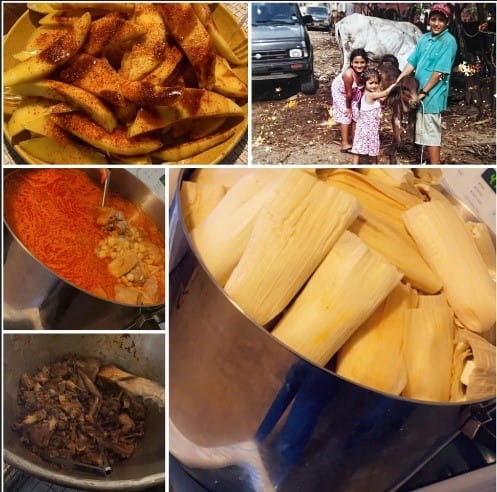This post is the latest in a series from GOJO team members and partners discussing how cultural experiences shape each of us and our communities. These stories are an important part of how we gain new perspectives, learn from others, and ensure GOJO is a place where everyone can bring their full authentic selves to the pursuit of our Purpose.
My Favorite Way to Celebrate My Hispanic Heritage is Through Food
By Vanessa Santiago Escaso, Quality Control Analytical Supervisor, GOJO
 What image comes to mind when you think of the Hispanic population? Most of the time, non-Hispanics think of us as a group of people who speak Spanish. That is true, but being Hispanic means so much more than that!
What image comes to mind when you think of the Hispanic population? Most of the time, non-Hispanics think of us as a group of people who speak Spanish. That is true, but being Hispanic means so much more than that!
In my case, I was born on the Caribbean Island of Puerto Rico, where the cultural mix of indigenous Taino, West Africans, and Spanish (and other) Europeans is evident in our language and culture. My favorite way of celebrating this heritage is through one of the most enriching (and delicious!) cultural traits: food.
I ate rice and beans every single day while growing up. Rice has been a staple in the Puerto Rican diet since early colonization; it was brought over from Africa often in slave ships. African people were the first to apply their agricultural techniques to grow it in the coastal wetlands. The beans are cooked in a stew using our traditional sofrito, a purée of vegetables, herbs, and fat sauteed as a base to add flavor. This cooking technique traces back to the Taino natives. The non-native ingredients the sofrito recipe calls for, like olive oil, olives, and garlic, were imported by Spaniards to satisfy the European taste. But my all-time favorite Puerto Rican dish is mofongo - the art of frying and mashing plantains with a heavenly combination of salt, garlic, and pork crackling, which also traces back to our African roots.
Other Hispanic countries will celebrate with tamales and mole (Mexican), or pupusas (Salvadorian), or asados (Argentinian), or ceviche and lomo saltado (Peruvian), and many more cuisines that are rooted in their own traditions and history.
During this month’s celebration of Hispanic Heritage, let’s celebrate the uniqueness of each member of this population. Let’s try different Latin cuisines and support authentic restaurants and shops. Let’s be curious and remind ourselves that not all Hispanics are built the same. To celebrate Hispanic heritage is to celebrate all those differences that, instead of dividing, they expand our knowledge and our own culture, and move us toward an inclusive and diverse population. Happy Hispanic Heritage month!
Local Puerto Rican restaurants (in order of my personal preference):
- Cleveland Mofongo
- Jibaro
- Rincon Criollo Cleveland
- Empanadas
- Twisted Taino
- Caribe Bake Shop
Additional local Hispanic restaurants and bakeries:
National Hispanic Heritage Month Is About Celebrating Our Cultures
By Ismael Penalosa, Distribution Coordinator, GOJO Navarre
 I was born in Bakersfield, CA. My mother raised me alone, and she was always there in the best way she could be. Throughout my childhood, we moved around a lot, always looking for a better life. We moved from California to Washington. Later we moved to Illinois, then Wisconsin, then to Mexico, then Arizona, then back to Illinois, and finally Ohio.
I was born in Bakersfield, CA. My mother raised me alone, and she was always there in the best way she could be. Throughout my childhood, we moved around a lot, always looking for a better life. We moved from California to Washington. Later we moved to Illinois, then Wisconsin, then to Mexico, then Arizona, then back to Illinois, and finally Ohio.
Growing up, we were just trying to survive. It was that way for many Latino cultures. When it came to aid in the form of food stamps and other support, many people in the community would struggle due to cultural and language barriers. They would be hesitant to ask for assistance or could not ask. Help and support through family and friends is very common in our culture, but for those who were born or spent most of their time in the U.S., it is different. Here in the U.S., it is more common to accept the idea that people who aren’t successful were “lazy,” or victims of their own circumstances. In reality, we’re all going through so much, and we benefit from raising one another up.
I was 12 when we moved to Michoacán, Mexico, where we lived for five years. In Mexico, we would sleep on a petate rather than a bed. The first two years, we lived close to the coast, and to make money, we would do whatever we had to do. I would collect glass bottles or aluminum cans, I operated a pushcart selling ice cream, and I would sell chicles (chewing gum). The last three years in Michoacán, we moved inland to a small-town area where it was nothing but farmland and farm work, but I would enjoy eating fresh papaya and mango, and drinking fresh milk and eating fresh cheese straight from the cow.
There were numerous indigenous groups that lived in Michoacán, and we would pay them for seasonal work on the farmland. When we worked on the farm, we would both drink out of cantaros, which kept water cool. My mother was very generous, and she would often donate clothing to those in need, including some of my own clothes and shoes. In Mexico, we did not wear tennis shoes. Instead, we wore waraches (sandals) made of tire treads. I used to get upset when my mother would donate my things, but over time I realized what it meant to help others and give to those in need. It’s one of the many things I am proud of in my culture.
How I celebrate National Hispanic Heritage Month
This time of the year is our equivalent to the 4th of July, as many Latino cultures gained their independence around this time (Mexico’s Independence Day is September 16th). People often mistake this with Cinco de Mayo.
For me and many others, National Hispanic Heritage Month is about celebrating our cultures. Celebrating family. Celebrating being alive. Celebrating freedom, and success, and overcoming hardship. Latino cultures are very welcoming of one another, regardless of your specific background. When I was in Mexico, I remember that the whole city was like one large continuous party where you could walk from one party to the next. There are so many holidays and occasions that occur in the last third of the year, it is like one continuous celebration.
 I celebrate with my family with traditional food, drink, music, and dancing. The food would consist of pazole, tamales with champurrado, elote, baracoa, tres leches, and plenty of rice, beans, and tortillas. For beverages, we have horchata, tamarindo, Jamaica, and plenty of cervezas: Modelo, Corona, Tecate, Victora, Pacifico, and of course, Don Julio.
I celebrate with my family with traditional food, drink, music, and dancing. The food would consist of pazole, tamales with champurrado, elote, baracoa, tres leches, and plenty of rice, beans, and tortillas. For beverages, we have horchata, tamarindo, Jamaica, and plenty of cervezas: Modelo, Corona, Tecate, Victora, Pacifico, and of course, Don Julio.
Music plays all the time, musical genres like Mariachi Ranchero, Banda, Cumbia, Salsa, and Grupero Regional Mexicano, with great artists like Vicente Fernandez and Juan Gabriel, and traditional groups like Los Tingres Del Norte and Banda el Recodo. We sing along karaoke-style and dance to it as well. Our culture is traditionally religious, and many of our celebrations are accompanied with “danzes” (a tradition in Catholicism to honor Our Lady of Guadalupe in the midst of the Advent season), where people would dance for the virgin Mary. My brother would dance, and he would really get into it, but I didn’t dance.
Food and Beverages Glossary:
- Pozole - a traditional stew.
- Tamales - meat and/or vegetables in dough made of corn and cooked in corn husks
- Champurrado - a thick beverage served warm, made with milk, sugar chocolate, and cinnamon (often paired with Tamales)
- Elote - corn with butter, mayo, chili powder, and cotija cheese
- Barbacoa - a seasoned meat made of beef, lamb, goat (known as birria) or another meat
- Tres Leches - a classic cake recipe
- Rice, Beans, and Tortillas
- Horchata - a sweet drink made with rice
- Tamarindo - a sweet agua fresca (“fresh water”) drink made with tamarind and sugar
- Jamaica - (pronounced “Ha-mike-ah”) a sweet and tart agua fresca fruit drink made from hibiscus flowers